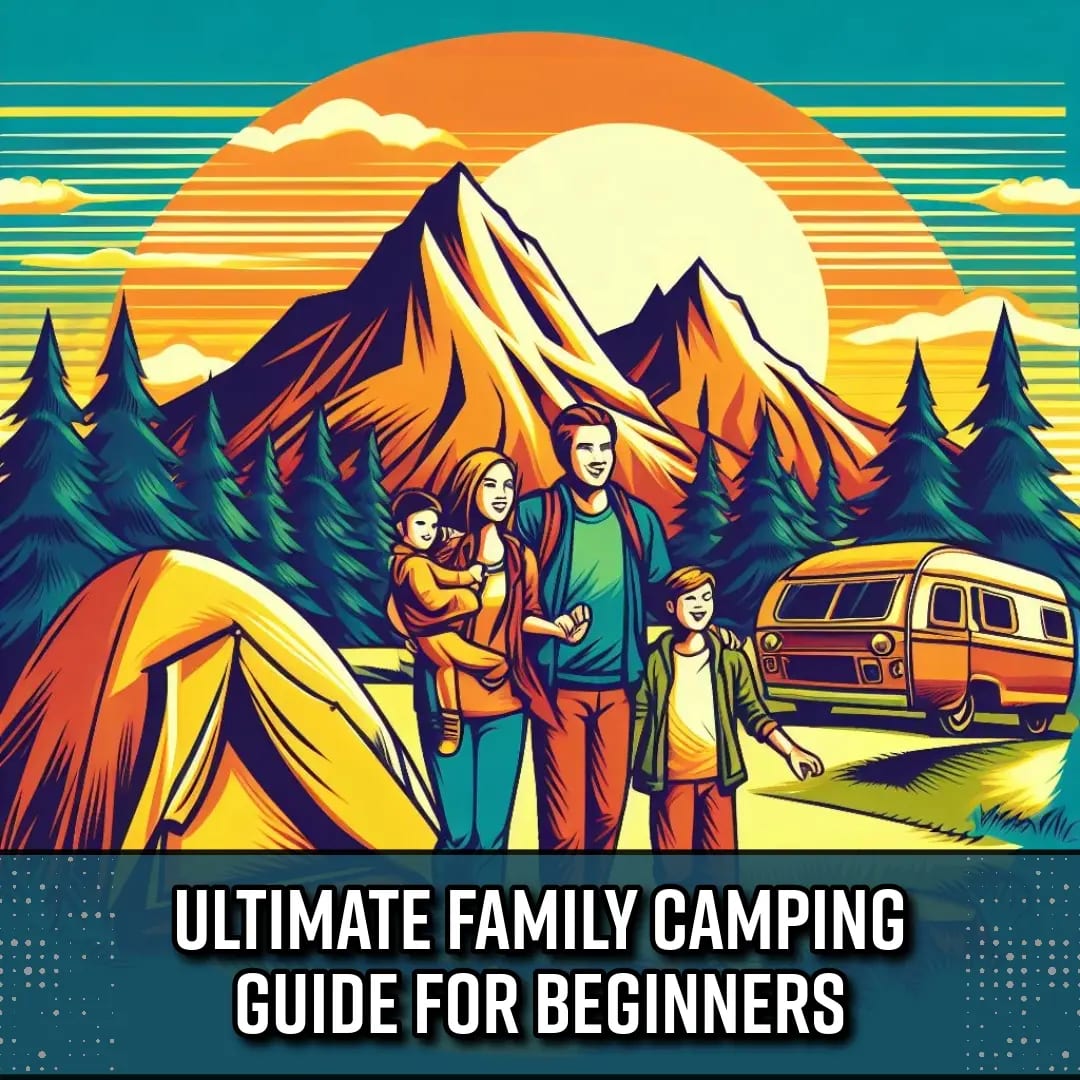The campfire is central to many of the best activities at camp and an iconic part of the camping experience. Some of the best camping memories are made around the fire. So let’s go over a few simple campfire safety tips so you know to make those memories safely. Also, if you are a new camper you might be interested in reading our guide for beginner campers.
According to the National Park Service, 85% of wildfires are caused by humans. I couldn’t find the actual numbers but many of those fires are caused by campfires that got out of control. In addition to possibly burning down the forest you’re camping in, there is also the risk of injury. I can tell you from personal experience that getting a major burn will ruin your camping trip. So, now that I’ve sufficiently scared you, let’s get to the campfire safety tips.

Key Takeaways:
- Know the campfire rules and regulations of the area you are camping in.
- Use the designated fire pit or, if necessary, dig a fire pit away from hazards.
- Build a safe campfire by starting with tinder, adding kindling, and gradually adding larger pieces of wood.
- Always use matches and never use flammable liquids to start a campfire.
- Use local firewood to prevent the spread of harmful insects and diseases.
- Keep water and a shovel nearby for fire suppression.
- Be mindful of wind conditions and keep flammable objects away from the fire.
Know the Rules
Prior to starting a campfire, it is crucial to familiarize yourself with the campfire safety rules and regulations of the specific campground or wilderness area you are visiting. These rules may vary from one location to another, and some areas may temporarily prohibit campfires altogether if the risk of wildfires is high. To ensure a safe and enjoyable campfire experience, it is essential to pay attention to any posted signs and check with park rangers for the most up-to-date campfire regulations.
By knowing and adhering to the rules, you can plan your campfire activities accordingly. This includes understanding restrictions on the size and type of fires allowed, designated fire pit locations, and any specific precautions or guidelines you need to follow. Being well-informed about the campfire regulations not only helps prevent accidents but also ensures that you are being a responsible camper and taking necessary steps to protect the surrounding environment.
| Rule | Description |
|---|---|
| Check for Bans | Be aware of any temporary campfire bans or restrictions in the area. |
| Follow Size Limits | Adhere to the maximum size limits for campfires as specified by the campground or wilderness area. |
| Use Designated Fire Pits | Only build campfires in designated fire pits or fire rings provided by the campground. |
| Observe Prohibited Materials | Avoid using flammable liquids, such as lighter fluid or gasoline, to start or enhance your campfire. |
| Extinguish Completely | Ensure the campfire is completely extinguished before leaving by dousing it with water and stirring the ashes. |

The 7 Campfire Safety Tips
1. Keep the area around the campfire clear
To keep flying embers from starting fires keep everything flammable, including extra firewood and especially your tent, at least 15 feet (4.5 meters) from the firepit. Keep the stuff you aren’t storing (chairs, blankets, clothes, etc) at least 10 feet (3 meters) from the campfire when not being used.
2. Watch children and pets
Children and pets are especially at risk of getting burned when they are allowed to be close to the campfire. For that reason, it is highly recommended to keep them at least 10 feet (3 meters) from the campfire at all times. The only exception to that rule is when they are being held by an adult. A trip and fall into a campfire is a life-threatening emergency and should never be risked.
3. Never Leave a Burning Campfire Unattended
An unattended campfire can get out of control surprisingly quickly, especially if the wind changes. Therefore it is important that a responsible adult be present whenever a campfire is burning. If that isn’t possible put the fire out properly before leaving.
4. Keep the Campfire Small
This seems like common sense but keep your campfire small. Not only will a small fire be safer and less likely to get out of control, but it is easier to time when it will burn out. This is nice when you are getting ready to go to bed or leave camp. As a bonus small campfires are usually less smokey.
5. Watch the Wind
There are many different factors that influence how wind speed impacts a campfire. Things like fuel moisture, humidity, temperature, and how dry the surrounding area is. Instead of doing complicated calculations pay attention to the sparks and embers being thrown off from the fire. If they start traveling too far adjust the size of the fire.
As a rule, if the fire can’t be reduced to a safe size, or if winds get stronger than 20 miles per hour (32 km/hr) the fire needs to be put out.
6. Keep a Water Bucket and Shovel Nearby
You don’t need much equipment to have a safe campfire but there are two things. Luckily they are things that you might already have. You will need a bucket of water and a long-handled shovel. Both of these things need to be near the fire at all times. You will use them not only in case of emergencies but also while putting the fire out.
The water bucket is pretty self-explanatory. Just make sure that it is large enough so that you won’t have to refill it if the fire gets out of control. We suggest a 5-gallon bucket (19 liters) since they are cheap, easy to get, and large enough to double as a container during travel. If space is an issue you could get by with 3 gallons (11 liters) if you keep the fire small.
A good garden shovel is the best option. You will want the longer handle to give you some reach and leverage when stirring the water and ash. Many people have a hard time packing a full-sized shovel so if that’s the case I recommend one of the extendable ones. The one below is an excellent option.

RHINO USA Folding Survival Shovel w/Pick - Heavy Duty Carbon Steel Military Style Entrenching Tool for Off Road, Camping, Gardening, Beach, Digging Dirt, Sand, Mud & Snow. Compact & portable - full 23" long extended but only 9" x 6" when folded into included carry case.
7. Always put the fire out properly
Putting out a campfire properly isn’t difficult, but if done wrong hotspots can remain to reignite later. You will want to pour the bucket of water onto the campfire to drown it. Then use the shovel to mix up the ashes and coals until everything is cool to the touch. This includes the rocks around the campfire. If you need more water, add it. It’s better to leave a muddy puddle than start a wildfire. Then walk around the firepit looking for hot spots and embers to make sure they are out. Finally, double-check the firepit once more to be sure.

Conclusion
Ensuring campfire safety is crucial for a memorable and safe camping experience. By following these simple campfire safety tips, we can protect ourselves, others, and the environment. It is essential to know and adhere to the campfire rules and regulations of the area we are camping in. By using the designated fire pit or properly constructing a fire pit in remote areas, we can minimize the risk of wildfires and other fire hazards.
I hope these campfire safety tips help you to enjoy your next camping trip a bit more. As you can see it isn’t hard but still many injuries and fires are started each year when these campfire safety tips aren’t followed. Remember, always set up your fire in the provided firepit, and follow the Leave No Trace philosophy. Please let us know your thoughts in the comments below. We love hearing from you. Thanks for your time and remember “only you can prevent forest fires”.
FAQ
Q: Can I build a campfire outside of the designated fire pit?
A: For both safety and to reduce your footprint it is recommended to use the provided fire pit or, if not available, to create a fire pit in an open area away from hazards.
Q: How should I build a safe campfire?
A: Start with tinder, add kindling, and gradually add larger pieces of wood. Follow proper construction techniques for a safe campfire.
Q: What should I use to ignite the campfire?
A: Always use matches to ignite the fire and ensure they are completely extinguished before disposal.
Q: Why should I use local firewood?
A: Using local firewood reduces the risk of introducing harmful pests into new environments and helps minimize the ecological impact.
Q: Why should I keep water and a shovel nearby?
A: Water can be used to extinguish runaway flames, and a shovel can help throw sand or dirt on any flames that escape the fire ring. The shovel and water will also be used to extinguish the fire when you are done.
Q: What precautions should I take regarding kids and pets?
A: Keep children supervised near the campfire and teach them about fire dangers. Keep kids and pets away from the campfire unless they are on an adult's lap.
Q: Can I leave a campfire unattended?
A: Never leave a campfire unattended, even for a minute. Ensure that at least one person keeps a watchful eye on the fire at all times.
Related Blog Posts

Ready to take your family on their first camping adventure? Our comprehensive guide is the perfect resource for beginners! We cover everything you need to know to plan a successful and enjoyable camping trip with your family, from selecting the right campsite and equipment to packing essentials and preparing for emergencies.

We dive into the essentials of choosing the right tent stakes for varying camping conditions, from sandy beaches to rocky terrains. Learn about different types of stakes like spiral, screw-type, and heavy-duty steel, and discover which ones are best suited for soft soil, loose sand, or frozen ground. Our personal journey from frustration to camping bliss shows just how crucial the right stakes can be for a stress-free outdoor adventure.
By Summer and Bill

Summer and Bill are the dynamic duo behind Adventureite.com, a blog dedicated to inspiring others to explore the great outdoors. With a combined lifetime of experience traveling and adventuring across America, they have a wealth of knowledge to share. From hiking to camping, kayaking to travel, Summer and Bill are passionate about helping others discover the beauty of the natural world.
 Adventureite
Adventureite